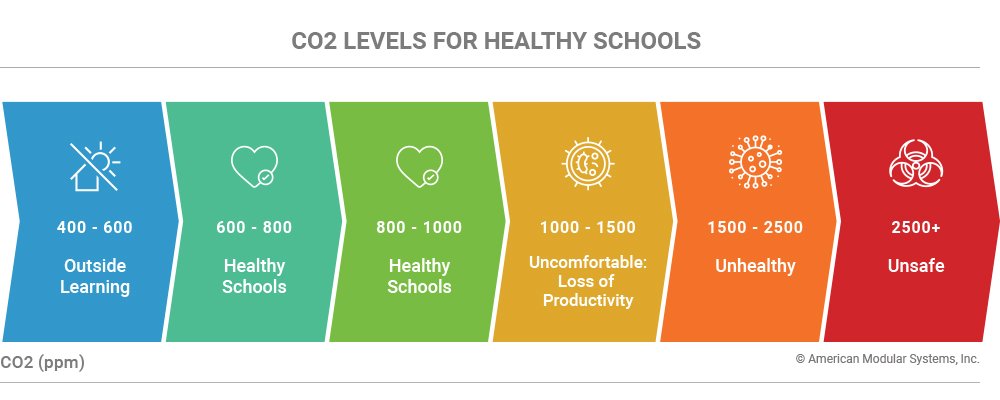Cleaner Air. Healthier Schools.

Schools focused on the immediate challenges of reopening safely are shifting their attention to the opportunity to design buildings that enhance the long-term health and productivity of students and teachers. That means addressing a problem we can’t even see—the air we breathe.
Unhealthy indoor air quality (IAQ) has long been an issue in schools, especially in California where many school buildings are aging and have inadequate ventilation. The World Health Organization has stressed the negative health effects of pollution on our lungs for decades, and COVID moved the problem off the backburner and up the priority list.
Improving classroom air is now a focus and rightfully so. Inhaling indoor contaminants not only spreads disease, it also triggers health problems like headaches, allergies and asthma—all detrimental to academic performance, a metric already in decline from the pandemic.
A Big Problem for Small Children
Poor IAQ affects everyone, especially students, whose lungs and brains are still developing. Children breathe in more air per pound of body weight than adults, making them more vulnerable.
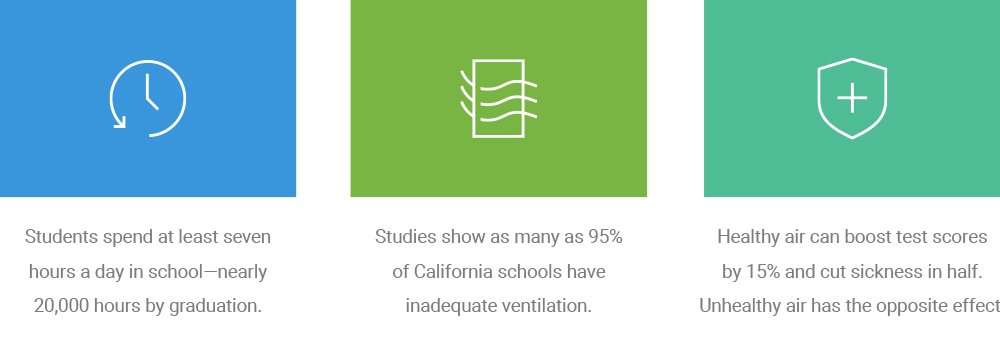
It’s a serious problem, but here’s some good news: schools can clean up indoor air quickly, and thanks to federal and state stimulus funding, they now have the budget.
Short-term fixes helped schools reopen, but the longer-term solution is to design facilities with the materials, systems and air quality controls to provide a clean-air environment mindful of the health and comfort of everyone inside.
Design Strategies for Cleaner Air
Healthier buildings start in planning, when schools have the ability to make the best design choices to achieve their IAQ goals.
Inadequate ventilation, contaminants from indoor and outdoor sources and poor system maintenance put student’s and teacher’s physical and mental health at risk. And all are controllable with smart planning and design.
Five IAQ strategies give schools a multi-layer plan for creating—and maintaining—a healthy, clean-air environment that improves learning and helps students achieve academic success.
Reduce VOCs
The first line of defense is to keep as many contaminants out of the air as possible.
Many indoor pollutants include volatile organic compounds (VOCs), like benzene and formaldehyde, that off-gas from building materials, finishes, furniture, cleaning products and school supplies. VOC concentrations can be up to ten times higher indoors, ranging from mildly irritating to highly toxic.
The strategy is the same for all of them: reduce exposure.
- Choose low-emitting materials, finishes and adhesives that off-gas at safe levels.
- Keep design low maintenance to reduce upkeep and the need for strong chemicals.
- Use EPA Safer Choice or Green Seal certified cleaners to avoid releasing harmful toxins into the air.
Bring in Outside Air
Germs, dust and mold spores spread rapidly when ventilation is poor. So any clean air solution starts with increasing the airflow in a room, bringing in fresh outside air to dilute the concentration of indoor pollutants.
California follows ASHRAE 62 Ventilation for Acceptable Indoor Air Quality guidelines, which recommend a minimum of 15 cubic feet per minute (CFM) of outdoor air for each person in the ventilation system service area.
Most California schools don’t meet this standard. To improve indoor air, schools need to increase ventilation, either manually through outside access or mechanically through an HVAC system.
OUTSIDE ACCESS
At home, people can open a window or door whenever they want fresh air. If a school has operable windows or a door to the outside, that’s a simple solution with an immediate effect—as long as the air outside is a comfortable temperature and not heavily polluted.
An even healthier solution is to design for maximum airflow with sliding glass exterior walls that open classrooms to outdoor learning areas. AMS offers clear glass NanaWalls as a design option that brings in fresh air and natural light while expanding the building footprint. Physical and mental health improves, productivity increases and students love learning in an unrestricted environment where they can spread out and move about freely.
But many schools have only view windows, and if classrooms open to an interior corridor, fresh air is dependent on the HVAC system.
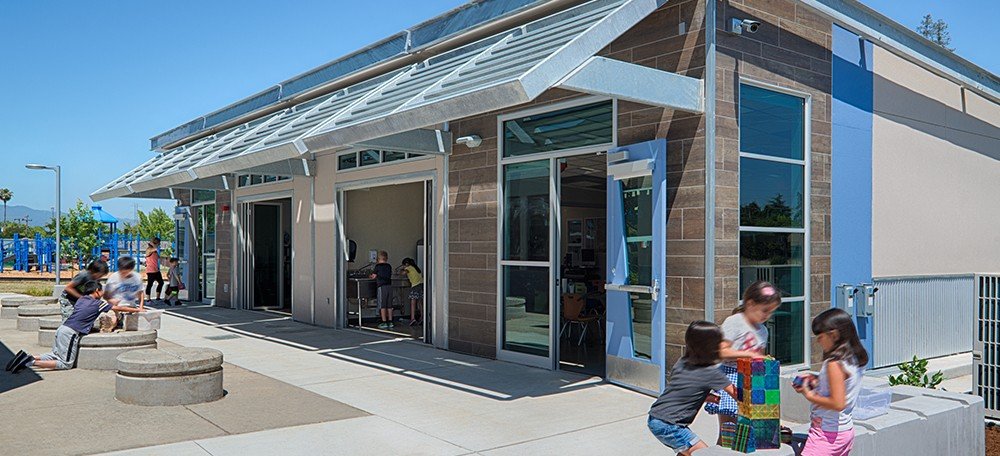
HVAC ENHANCEMENTS
Even with outdoor learning spaces, the majority of learning takes place inside a classroom. Design can compensate by increasing the outside air supply with a natural ventilation system adjusted to circulate the right amount of fresh outside air.
Unfortunately, many schools are unlikely to improve fresh air ventilation without system upgrades or enhancements.
A 2019 UC Davis study found that about 85% of HVAC systems recently installed in California K-12 classrooms were under-ventilated, meaning only 15% of classrooms met the minimum ventilation standard, even with newer equipment.
Replacing the HVAC system or running it continuously isn’t always the answer; sometimes, system performance is best enhanced by adding components that deliver air at a higher level.
Economizers
Continuous circulation of air lowers health risks, but it comes at a cost: higher electric bills. An outside HVAC system with an economizer provides a balance, controlling both air quality and energy usage. When outside air drops below a building’s interior temperature, the economizer draws in just enough outside air to cool the building, cycling out stale indoor air to keep classrooms well-ventilated.
With an economizer sharing the cooling load, the HVAC compressor runs less, lowering operating costs. Less wear on the compressor means fewer repairs and deferred replacement costs, saving schools even more. Advanced economizer models connect to multi-zone thermostats, giving teachers more control over the comfort of their classrooms.
Dedicated Outside Air System
Most HVAC equipment is designed to bring in a lower percentage of outside air—around 20%. A dedicated outside air system (DOAS) can condition up to 100% outdoor air in all weather conditions, supplying cooled, dehumidified outside air in summer and heated outside air in winter.
A dedicated ventilation unit works with the HVAC system to efficiently process and manage ventilation, adjusting heating and cooling capacity to deliver the precise amount of air, at programmed temperature and humidity levels. A DOAS maintains a consistent temperature in individual classrooms, avoiding the disruptive temperature swings of single-stage equipment.
Demand Controlled Ventilation
While classrooms are designed for peak occupancy, they’re vacant more than half the time. Demand controlled ventilation (DCV) uses occupancy sensors to regulate ventilation based on the number of people in the room, reducing airflow when classrooms are operating below design capacity and increasing it to provide occupants with the correct amount of fresh air when needed.
DCV is more efficient than time-scheduled ventilation, fully automating outdoor air intake for around-the-clock climate control. When ventilation requirements are low, the system calls for less outside air to be cooled or heated, reducing peak power demand and yielding significant cost savings for schools.
Enhance Filtration
While a ventilation system brings in outside air, the filtration system cleans it. Smart building design integrates the two to create an optimized learning environment.
Recirculating unfiltered air is unhealthy. Allergens, viruses and bacteria are everywhere. Once contaminants are in the air, they need to be removed.
MERV 13+ AIR FILTERS
Most air cleaning technologies use a disposable filter that’s inserted into an HVAC system’s airflow path, where it traps airborne particles, removing them from circulation.
Recycled air should be filtered at the highest possible efficiency for the system’s design. ASHRAE rates filters on a Minimum Efficiency Reporting Value (MERV) scale ranging from 1 to 16, with MERV 13+ the recommendation for schools. The higher the MERV rating, the stronger the filter and the cleaner the air.
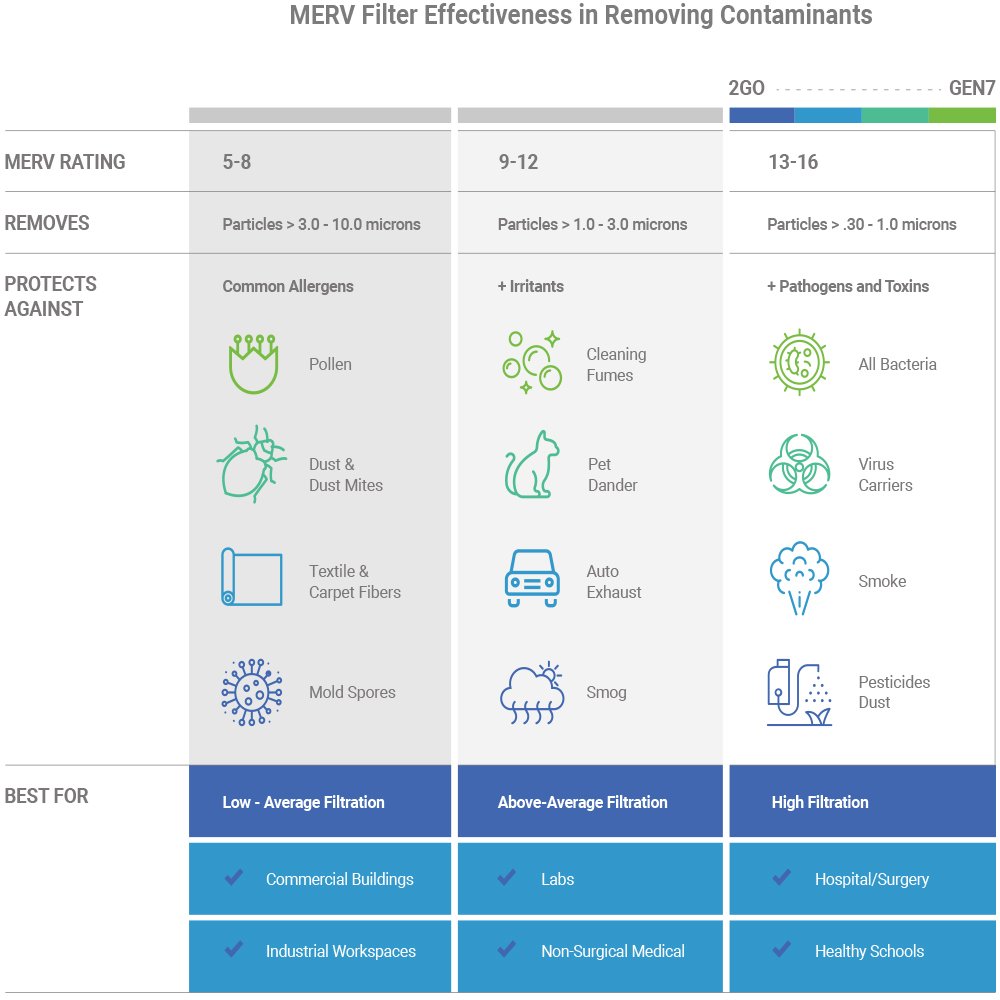
AMS has upgraded the air filtration systems in all AMS buildings to MERV 13+ filters in AMS brands and MERV 16 filters in all GEN7 Series. MERV 13+ filters are high-efficiency, removing up to 95% of common irritants, bacteria and virus particles from the air.
Changing filters every 90 days (or as recommended by the manufacturer) maintains an unrestricted airflow, keeping the HVAC system working efficiently to circulate healthy levels of clean air.
AIR PURIFIERS
For schools wanting an extra layer of protection, two types of air purifiers work with ventilation and filtration systems to remove virtually 100% of airborne particles.
Iconic Air Purifiers
Ionization has become a sophisticated technology for purifying indoor air. As air cycles through the HVAC system, an ionic air purifier adds an electromagnetic charge to airborne particles like dust and mold spores. The charged particles are released into the classroom, eventually circulating back into the ionizer where they’re captured and filtered from the air.
UV Air Purifiers
UV air purifiers use advanced ultraviolet germicidal irradiation (UVGI) technology. Installed in ducts near the HVAC unit, UV air purifiers mimic the antimicrobial power of sunlight to eradicate harmful pathogens as they flow past. Because it actually kills viruses instead of trapping them in a filter, a UV air purifier is very effective in preventing the spread of disease-causing viruses and bacteria.
Monitor and Control CO2
Every time a person exhales, carbon dioxide (CO2) is released into the air and recirculated by a building’s HVAC system. Measuring the CO2 level is a proxy for measuring ventilation, a quick indicator of whether a room has an acceptable fresh air intake for its occupancy.
Typical outdoor air has a CO2 level around 400 parts per million (ppm). According to ASHRAE standards, occupied indoor spaces with CO2 levels below 1,000 ppm have an adequate air exchange, while CO2 levels above that benchmark show progressively poor air quality that can cause cognitive impairment and present significant health risks.
CO2 sensors connected to a DCV system monitor and adjust air intake to maintain proper classroom ventilation. When the DCV system is disconnected to provide continuous airflow, a stand-alone air quality monitoring system can collect and transmit real-time data to an online dashboard programmed to send IAQ alerts or auto-adjust ventilation to a pre-determined CO2 setpoint.
Most air quality monitoring systems include sensors that can monitor temperature and relative indoor humidity, as well as radon, carbon monoxide (CO), ozone (O3) and VOC levels, giving schools control over the key variables affecting the quality of indoor air.
Commission and Maintain Systems
Once schools invest in the right equipment, it pays to conduct checks to maximize the performance of all system components—something many schools neglect to do.
Working with experts to commission new systems and maintain them for ongoing performance extends the service life of expensive equipment and keeps building interiors safe and comfortable for learning.
COMISSIONING
Healthy building design prioritizes ventilation and filtration but an onsite walkthrough, assessment and testing—known as commissioning—completes the circuit, ensuring that all building systems are set up correctly and operating as designed.
AMS recommends that all new projects be commissioned at the end of construction to confirm that HVAC, controls and lighting systems work together efficiently and perform at the level intended.
REGULAR MAINTENANCE
A regulated environment is a healthy environment, improving wellness, comfort and academic outcomes. But only if it’s maintained to standard.
Technicians suggest that operating an inefficient HVAC system year-round can consume as much as 30% of a building’s energy costs—costs that can be lowered by keeping systems in peak condition.
Most IAQ problems in schools can be controlled by providing an adequate supply of fresh outdoor air, controlling indoor humidity and providing effective particulate filtration of recirculated air.
Scheduling regular inspections by certified technicians can identify and resolve small issues before they become big ones. Between inspections, schools can run through a checklist to evaluate HVAC performance and make sure system components are hitting target levels.
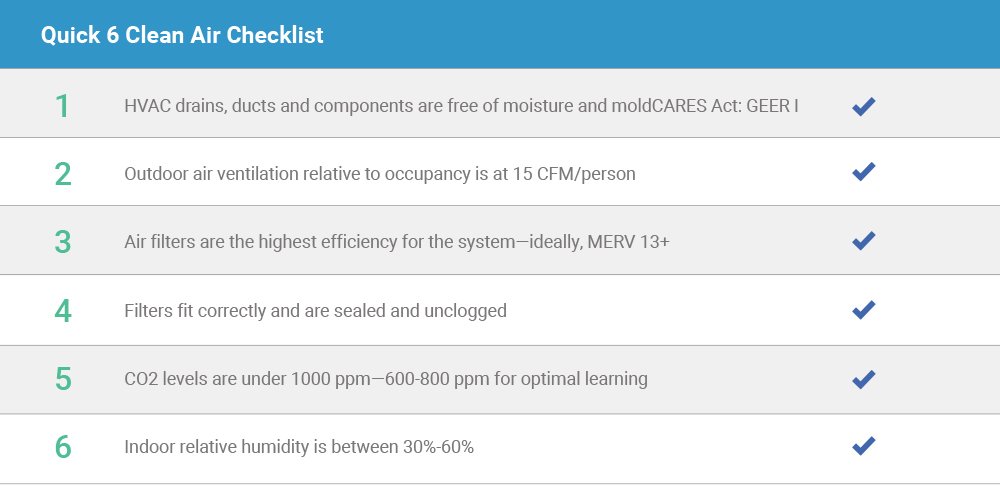
Planning for the Future
With stimulus funds available through 2024, schools have a window of time to design facilities that prioritize the ongoing health and safety of students and teachers.
There are clean air solutions for every budget, and AMS can incorporate them into any building. We blend design and technology, helping schools select the right equipment and materials, matching systems to goals and automating controls to create the best possible learning environment.
Our GEN7 Series offers a roadmap for creating cleaner air and healthier schools. We’ll show how GEN7 has improved health and productivity in two California schools, share IAQ strategies we’re using in new AMS buildings and highlight innovative air quality technologies to consider in Part 2 of our IAQ blog series.
See why our GEN7 brand is the model for superior IAQ.
Learn how sustainable modular classrooms elevate learning.
Want a clean air-design for your project? Request a Quote.
